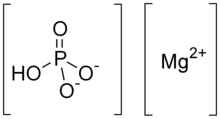Dimagnesium phosphate

| |
| Names | |
|---|---|
| Other names
Magnesium hydrogen phosphate; Magnesium phosphate dibasic
| |
| Identifiers | |
3D model (JSmol)
|
|
| ChemSpider | |
| EC Number |
|
PubChem CID
|
|
| UNII |
|
| |
| |
| Properties | |
| HMgO4P | |
| Molar mass | 120.283 g·mol−1 |
| Density | 2.13 g/cm3 trihydrate |
| Hazards | |
| NFPA 704 (fire diamond) | <imagemap>
File:NFPA 704.svg|80px|alt=NFPA 704 four-colored diamond poly 150 150 300 300 150 450 0 300 Health 0: Exposure under fire conditions would offer no hazard beyond that of ordinary combustible material. E.g. sodium chloride poly 300 0 450 150 300 300 150 150 Flammability 0: Will not burn. E.g. water poly 450 150 600 300 450 450 300 300 Instability 0: Normally stable, even under fire exposure conditions, and is not reactive with water. E.g. liquid nitrogen poly 300 300 450 450 300 600 150 450 Special hazards (white): no code desc none </imagemap> |
Except where otherwise noted, data are given for materials in their standard state (at 25 °C [77 °F], 100 kPa).
| |
Dimagnesium phosphate is a compound with formula MgHPO4. It is a Mg2+ salt of monohydrogen phosphate. The trihydrate is well known, occurring as a mineral.[1]
It can be formed by reaction of stoichiometric quantities of magnesium oxide with phosphoric acid.
- MgO + H3PO4 → MgHPO4 + H2O
Dissolving monomagnesium phosphate in water, forms phosphoric acid and depositing a solid precipitate of dimagnesium phosphate trihydrate:
- Mg(H2PO4)2 + 3 H2O → Mg(HPO4).3H2O + H3PO4
The compound is used as a nutritional supplement, especially for infants and athletes. Its E number is E343.[2]
See also
References
- ^ Klaus Schrödter; Gerhard Bettermann; Thomas Staffel; Friedrich Wahl; Thomas Klein; Thomas Hofmann (2008). "Phosphoric Acid and Phosphates". Ullmann's Encyclopedia of Industrial Chemistry. Ullmann’s Encyclopedia of Industrial Chemistry. Weinheim: Wiley-VCH. doi:10.1002/14356007.a19_465.pub3. ISBN 978-3527306732. S2CID 94458523.
- ^ relevant part of the German “Zusatzstoff-Zulassungsverordnung Archived 2012-05-18 at the Wayback Machine”, the official German implementation of the respective regulation of the European Union
- Webarchive template wayback links
- Chemical articles with multiple compound IDs
- Chemical articles with multiple CAS registry numbers
- Articles without InChI source
- Articles without EBI source
- Articles without KEGG source
- Articles with changed InChI identifier
- Short description with empty Wikidata description
- Acid salts
- Phosphates
- Magnesium compounds
- E-number additives
- Inorganic compound stubs